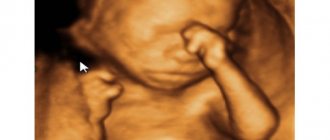In Russia it is generally accepted that if a child is born large, it means the parents are lucky: “the hero will be healthy and strong.” However, doctors believe otherwise, because pregnancy and childbirth with a large child can be fraught with complications for the newborn and the mother.
Obstetricians and gynecologists state that a child was born large, if its body weight reaches 4-5 kg, a fetus over 5 kg is called gigantic. The body of both a large newborn child and a giant, in addition to “serious” weight, may also have other non-standard parameters. Statistics say that large children have begun to be born much more often over the past decade. But giant babies, on the contrary, are born less often.
Why are big babies born?
If a mother has a large baby, there may be many reasons for this. And not all of them are pathological. However, doctors classify some of them as risk factors.
- Illiterate nutrition. When a pregnant woman exceeds the needs of her body and the growing fetus by consuming too high-calorie foods and not moving enough, the excess calories cannot be adequately absorbed. This has an adverse effect on the metabolic processes in the mother’s body, because not only sugar, but also cholesterol and lipids increase in her blood. As a result, your rate of weight gain causes a large baby to develop during pregnancy. Growth and gain of muscle mass, as well as the formation of organs and systems of the fetus occur in the third trimester. And if during this period the pregnant woman’s weight increases by more than 500 g per week, this may indicate alarming indicators: either that the pregnant woman is storing excess fat, or that she is developing edema.
- Hereditary causes. If the parents are tall, have harmonious development and excellent health, gynecologists say that the appearance of a large child is hereditary. Typically, such a fetus at birth has a large body weight and a length proportional to it, but the baby does not have any pathologies. You can predict the likelihood of pathology in a large child using ultrasound by comparing the length of the femur and the circumference of the fetal abdomen. If a woman has already given birth to a large child (for example, if the second child is larger than the first and now the mother is expecting a third; or if the first child is larger than the second), then there is a high probability of giving birth to a “hero” again. This pattern, according to gynecologists, may be associated with the characteristics of blood flow in the placenta and uterus.
- Diabetes. In diabetes mellitus, metabolism and the ability to absorb glucose normally are impaired. However, the glucose level increases not only in the mother’s blood, but also in the umbilical cord blood of the fetus. For this reason, the weight of the fetus increases, and changes in lipid metabolism cause the deposition of fat reserves, which is why fetal growth changes unevenly (it either slows down or accelerates). In this case, a large child is born with disharmonious signs: a face with signs of puffiness, a short neck, a wide and large shoulder girdle and torso, since the child’s spleen and liver are enlarged due to accumulated subcutaneous fat. The length of the body of such a child is also increased, but disproportionately: he has a rather large stomach, and the ratio of the length of the femur to the circumference of the abdomen is below normal values.
- Obesity. When lipid metabolism is disrupted in a pregnant woman's body, free fatty acids from the mother's blood enter the fetus, which provokes its rapid growth. But not only obesity in the mother can contribute to the fact that the child was born large: excess body weight in the father is also a risk factor. Answer the question “Why is the child of an obese woman large?” you can do this: since an obese woman’s blood sugar level increases in the second half of pregnancy, glucose absorption worsens under such circumstances. As a result, so-called “relative insulin deficiency” occurs (often called “latent diabetes mellitus”). When a sufficiently large amount of glucose enters the fetus’s body, its pancreas experiences increased stress. This not only causes a large baby at birth, but also an additional risk of diabetes in a woman.
- Post-term fetus. Pregnancy can be physiologically prolonged by 2 weeks - under such natural circumstances the fetus does not suffer. But with the so-called “biological post-maturity,” signs of an overripe placenta appear. This leads not only to the fact that the child was born large, but the newborn develops denser and more massive skull bones, and the fontanel becomes less extensible. For these reasons, the mobility of the skull bones in the fetus decreases, which can seriously complicate the course of childbirth.
- “Special” placenta. The reason for the development of a large child may also be the volume and size of the placenta. If the baby was born large, the thickness and area of the placenta are usually increased - because of this, the fetus develops at an accelerated pace. It is no coincidence that in a pregnant woman with the development of a large child, gynecologists often note a change in the level of placental hormones in the blood. If the blood supply to the placenta is intensive, the volume of blood circulating in it increases, the fetus receives significantly more nutrients, which causes the appearance of a large baby at birth. Another reason is the placenta, located on the back wall of the uterus: under such conditions, the blood supply to the fetus is also increased.
- Repeated (third, fourth, fifth) pregnancy. A large baby during a second pregnancy is not uncommon, because the network of blood vessels in the uterine wall is better developed than during the first two gestations, and the distensibility of the uterus also improves - all this creates conditions for the development of a large fetus.
- Long-term use of drugs, inflammatory diseases in women. The use of certain drugs and the development of inflammatory diseases can promote increased blood circulation in the vessels of the uterus and placenta. And as a result, lead to the formation of a large fruit.
What is the danger of deviation of fetometry indicators from the norm?
Deviations from the norm always raise suspicions. If the baby’s physical parameters fall outside the range of normal values, this should be taken into account as carefully as possible—the child may have developmental abnormalities. Of course, “possibly” does not mean “definitely.” Not considered critical if:
- one of the indicators lags behind or exceeds the norm by one or two weeks;
- all indicators “belong” to the same week of development, and are shifted no more than a couple of lines relative to the norm;
- the indicators belong to different weeks, but the difference between them is no more than one line.
Excess weight and height may indicate excess nutrition of the fetus, disturbances in the functioning of the internal organs of the expectant mother, or Rh conflict between mother and child.
The cause of lack of weight and height is often malnutrition of the fetus, intrauterine growth retardation, or frozen pregnancy.
Deviations in the intrauterine parameters of the fetus may also indicate chromosomal abnormalities or gross malformations of the child.
If the doctor diagnoses a deviation in the development of the fetus, he prescribes additional examinations that will provide more accurate data about the presence of deviations, their cause and the possibility of compensation.
Diagnosis of a large fetus
- Traditional methods: the gynecologist will measure the height of the uterine fundus above the womb and the circumference of the pregnant woman’s abdomen. If at approximately the 24th week these parameters exceed the norm (abdominal volume is more than 100 cm at the level of the navel, the height of the uterine fundus exceeds 42 cm), then they will indicate the formation of a large fetus.
- An ultrasound will determine more accurate parameters: the study will show the size of the child’s head between the temporal regions, the circumference of his abdomen and the length of the femur. By comparing the numbers, the doctor will clarify assumptions about a large fetus.
- Pregnant weight. If a pregnant woman does not have symptoms of gestosis (high blood pressure, protein in the urine, edema), then a weight gain of more than 500 grams per week will be a signal of the development of a large fetus.
Table of fetal weight norms by week of pregnancy
The estimated fetal weight in the early stages is calculated using ultrasound.
At a later stage, the doctor, thanks to measurements of the abdominal circumference and the height of the uterus, can calculate this indicator. Calculated child weight norms by week of pregnancy are presented in the table:
| weeks | Length, cm | Weight, g |
| 11 week | 4,1 | 7 |
| 12 week | 5,4 | 14 |
| Week 13 | 7,4 | 23 |
| Week 14 | 8,7 | 43 |
| Week 15 | 10,1 | 70 |
| Week 16 | 11,5 | 100 |
| Week 17 | 13 | 140 |
| Week 18 | 14,2 | 190 |
| Week 19 | 15,3 | 240 |
| Week 20 | 25,8 | 300 |
| 21 weeks | 26,7 | 360 |
| Week 22 | 27,8 | 430 |
| Week 23 | 28,9 | 500 |
| Week 24 | 30 | 600 |
| Week 25 | 34,6 | 670 |
| Week 26 | 35,6 | 760 |
| Week 27 | 36,6 | 875 |
| Week 28 | 37,6 | 1000 |
| Week 29 | 38,6 | 1150 |
| Week 30 | 39,9 | 1320 |
| 31 weeks | 41,1 | 1500 |
| Week 32 | 42,4 | 1700 |
| Week 33 | 43,8 | 1900 |
| 34 week | 45 | 2150 |
| Week 35 | 46,2 | 2380 |
| Week 36 | 47,4 | 2500 |
| Week 37 | 48,6 | 2800 |
| Week 38 | 49,8 | 3000 |
| Week 39 | 50,7 | 3300 |
| 40 week | 51,2 | 3400 |
Having a large baby: are complications possible?
If a large child is born due to a hereditary predisposition to healthy parents with tall stature and proportional build, this usually happens in a timely manner and without pathologies.
What might a woman carrying a large fetus face?
- Amniotic fluid is discharged prematurely. This may happen before labor begins or before the cervix opens. Due to the high position of the fetal head, the waters are no longer differentiated into anterior and posterior. Untimely discharge of water can provoke prolapse of the umbilical cord loop, and this is dangerous for the child’s life.
- Weak labor. If the contractions of the uterus are not coordinated, contractions become short or infrequent, so the uterus is slow to open. Therefore, it becomes more difficult for the child to move through the birth canal.
- Lack of oxygen in the fetus (hypoxia) can occur due to too long labor or due to infection (due to the fact that the fetus is in an anhydrous space for a long time).
- Shoulder dystocia in a newborn is a difficulty in the birth of the shoulder girdle. Usually the problem occurs in women with a clinically narrow pelvis, the size of which does not correspond to the size of the fetal shoulders. During childbirth, the baby's head moves normally along the birth canal, but the shoulders get stuck in them. When the obstetrician releases the shoulder girdle, serious injuries can occur - in the baby's collarbone, shoulders or cervical spine.
- Carrying out a caesarean section. In case of complicated childbirth, the woman usually undergoes a caesarean section. This is most likely in the case of a clinically narrow pelvis, if labor is weak or a breech presentation is observed in a large fetus, or the woman has a scar on the uterus, or if the pregnant woman is already old and carries the fetus to term.
- Amniotomy (opening of the membranes) is usually performed to stimulate sluggish labor.
What determines the weight of the fetus during pregnancy?
The weight of the child depends on the functioning of the placenta and the incoming nutrients with oxygen.
Starting from the second trimester, the fetus increases to 80 grams. In the later stages, the seven-day gain reaches 200 grams, but before labor the pace slows down significantly due to the death of the placenta. The indicator also depends on the following factors:
- unbalanced maternal diet;
- stressful situations during pregnancy;
- chronic diseases;
- toxicosis;
- smoking and alcohol abuse;
- genetic predisposition.
The weight of the baby during intrauterine development also depends on gender. Boys are born larger than girls.
Possible problems after birth for mother and large newborn
Mother's problems:
- Bleeding can occur due to the fact that the contractility of the uterus is reduced, and the area of the wound surface at the placenta insertion site is quite high. In such cases, the gynecologist removes the unseparated parts of the placenta and performs a manual massage of the uterus to force its muscles to contract and stop bleeding.
- Ruptures of the perineum and vagina. To prevent serious injuries from occurring, the obstetrician-gynecologist performs a dissection of the perineum during childbirth.
- Slow involution of the uterus (problems of its reverse development).
- Anemia (decreased hemoglobin in the blood).
- Problems with milk production.
- Thromboembolism is the formation of blood clots in the vessels of the legs.
- Inflammatory diseases (endometritis, symphysitis, mastitis).
- A woman with diabetes may experience premature birth.
Problems in a newborn:
- Intrauterine hypoxia of the fetus threatens with asphyxia - cessation of oxygen access.
- Slowing down the period of adaptation of the child to environmental conditions.
- Neurological disorders: tremors and restless behavior due to impaired cerebral circulation or birth injuries.
- Purulent-septic complications in a large child can occur due to primary immunodeficiency.
- Endocrinologists may also notice abnormalities in a large child with developmental disabilities. Moreover, these features can appear not only in a newborn, but also in a large child a year later, and in a later period. Large children are predisposed to the development of diabetes and obesity; they are more likely to develop neuropsychiatric disorders and allergies.
How to make pregnancy safe with a large baby
If the gynecologist has determined that the development of a large fetus is a risk for a pregnant woman, he may suggest the following:
- Hospitalization before birth to choose the right method of delivery.
- Changing your diet. At least during pregnancy, it is advisable to exclude all “bad” carbohydrates from the menu (yeast bread, buns, sweets, sweet soda, energy drinks, wheat flour pasta). Include more fruits, berries and proteins in your diet. If fat metabolism is impaired, try to count the calorie content of what you eat, not exceeding 1200 kcal per day. It is better to eat more often and in small portions.
- Physical exercise. They will help not only maintain weight and always be in good shape, but also strengthen the pelvic floor muscles (which will become your main assistants during childbirth), improve blood circulation, and reduce swelling.
- Monitoring and control of the condition of the uterus and fetus during childbirth: doctors will monitor the process of dilation of the cervix and the movement of the baby’s head through the birth canal. If labor weakness or other problems are detected, you will be provided with timely assistance.
- Vitamins and medications: painkillers, antispasmodics, therapy to induce labor, prevention of hypoxia in the fetus, drugs that promote uterine contraction during and after childbirth.
- Observation after childbirth. A large newborn must be carefully monitored and properly cared for - only then will a large child develop normally a year and older. The mother of a large child also needs to be monitored by a gynecologist and endocrinologist - especially if she has diabetes, metabolic problems, or obesity.
Normal fetal weight by week of pregnancy
In the first seven days after conception, the fertilized egg begins to divide, forming the placenta and fetus.
Until the 7th week, all vital organs are laid and formed. The outlines of a person appear - legs, arms, head, heart muscle. Already at the 5th week you can measure the baby. In the second trimester, the baby begins to grow rapidly. The rate of increase is about 80 g/week. Further, the weight of the fetus grows even more rapidly, reaching up to 300 g/week. During the 9-month period of intrauterine development, the uterus increases 500 times. Doctors, when assessing parameters on ultrasound, are guided by general indicators of size and circumference. The main component is the positive dynamics of the intrauterine formation of the baby and its full development. The approximate weight of a baby at 30 weeks is up to 1.4 kg. Any minor deviation can be perceived as a pathology or a normal condition, depending on the individual parameters of the expectant mother and the baby itself. By the beginning of labor, the baby reaches at least 3 kg 100 g.











